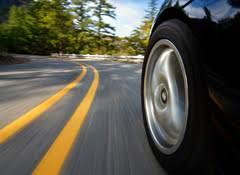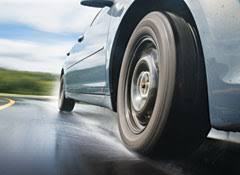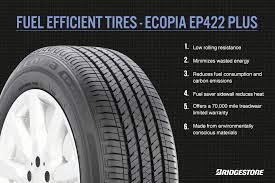Guide to Getting the Best MPG From Your Tires
If you buy a vehicle, chances are good that they come outfitted with a set of low rolling resistance (LRR) tires. Looking to improve their Corporate Average Fuel Economy (CAFE) numbers, manufacturers put a standard set of LRR tires on most new cars and light SUVs. These tires also tend to have a minimal amount of all-season capabilities, just enough to keep them remain steady on wet roads.

When you choose to replace a vehicle’s tires—or the tires of an entire fleet—you have the option of choosing even more fuel efficient low rolling resistance tires. But, this choice comes with trade-offs. For one, LRR tires tend to be a bit more expensive than their all-season counterparts. Another consideration is that low rolling resistance tread patterns and tire compounds can compromise performance grip, all-weather capabilities and tire life.
All of these trade-offs can still result in fuel economy savings for most vehicles. The most common estimates state that, for every 10 percent decrease in rolling resistance (in a light-duty vehicle), you can improve fuel economy by 1-to-2 percent. That may not sound like much, but it’s roughly the equivalent to $57 to $126 per year—enough to offset the cost of the tire and then some in just a few years.
Individuals and fleet managers should take care to keep their vehicles’ tires inflated and follow other best practices for the best fuel economy. Otherwise, you will wipe out any potential gains from installing LRR tires.
What Does Low Rolling Resistance Mean?
Low rolling resistance tires aim to reduce the amount of energy wasted when tires meet pavement.

Let’s back up. Tires propel our vehicles by generating friction on the road. Our engines spin the tires, and because tires are essentially able to “push” the vehicle, we get forward motion.
To get the amount of friction they need to move a vehicle, tires must flex, creating a flat surface when touching the ground. A perfectly stiff circular tire with no amount of flexibility would create a tiny surface area, leading to low grip and poor performance. As a result, most tires have some amount of flexibility, which creates a larger, flatter surface contact area.
It takes a greater amount of energy to make a tire flex or “deform” than it does for the tire to return to its original shape while it rolls. As a result, energy put into flexing the tire gets wasted, dissipating as heat. The more flexible a tire is, the more energy is lost as it bends.
This effect is called “hysteresis.” Since our vehicles use energy to flex the tire that doesn’t get put back, we lose a small amount of potential mileage from the used fuel source. Hence, lower MPG. More flexible tires—like under-inflated off-road tires—generate higher amounts of hysteresis, leading to more wasted energy. Low rolling resistance tires flex less, wasting smaller amounts of energy and saving MPG.
Do Low Rolling Resistance Tires Improve Fuel Economy?
Without a doubt, low rolling resistance tires offer a measurable, albeit small, improvement on fuel economy. The U.S. Department of Energy (USDE) estimates that petroleum-powered, light-duty vehicles use between 3-to-11 percent of their fuel just through rolling resistance and hysteresis. Heavier vehicles use even more energy at around 15-to-30 percent. Thus, using low rolling resistance tires on larger vehicles results in more savings.

Because they’re so efficient at propulsion, all-electric vehicles use an even larger portion of their energy overcoming rolling resistance, the equivalent of 23 percent in most cases.
As mentioned above, the most common statistic given regarding LRR fuel economy improvements is that, for every 10 percent decrease in rolling resistance, you gain 1-to-2 percent MPG. Industry-wide, numbers for overall mpg-estimated fuel economy improve anywhere from 2-to-7 percent.
According to a study by Consumer Reports and the University of Michigan, switching from a high rolling resistance tire to a low rolling resistance one can improve fuel economy by 1.3 MPG. Using an average mileage of 11,346 miles driven per year and an average gas price of $2.43 per gallon, the study determined that a vehicle would save roughly $78 per year on gas.
In real-world highway road tests, Consumer Reports discovered that the gap can be even larger—a 5.7 percent improvement, or 1.9 MPG overall.
Naturally, those maintaining a fleet that have higher-than-average mileages will extract multiplied benefits, leading to potentially significant fuel economy savings per year.
Low Rolling Resistance Tires Make a Difference, But Tread Carefully
The benefits of using low rolling resistance tires can be negated when a tire is improperly maintained. For instance, a single psi drop in tire pressure below the manufacturer’s recommendation leads to a 0.3 reduction in fuel efficiency. Therefore, having a vehicle’s tires just four psi below the recommendation completely negates the gains realized by LRR tires.

Other factors like vehicle weight can also hurt MPG. For every 100 lbs. of additional weight, vehicles lose an average of 1 percent of their fuel economy. Most importantly, drivers who accelerate aggressively can lower their fuel mileage anywhere from 10-to-40 percent.
When purchasing low rolling resistance tires, realize that there are also trade-offs to consider compared to other tire types. All-season tires, for instance, have better winter performance, wet road performance and performance on roads with loose debris compared to LRR tires. They also have tire lifespans extended by 10,000 or more miles on average.
That said, many new low rolling resistance tires offer improved traction and performance in a variety of conditions, lessening the trade-offs. Many LRR tires also promise extended mileage over their lifespan.
Research manufacturer-promised MPG gains against wet braking, estimated tire life and other performance metrics to determine an optimal scenario for your vehicles’s tire needs.
Conclusion
By considering their weaknesses, and using fuel efficiency practices that enhance their strengths, low rolling resistance tires can generate significant savings when multiplied across an entire fleet.
Even though fuel prices are cheap at the moment, they won’t stay low forever. By switching to LRR tires that meet performance and longevity needs, individuals and fleet owners can realize greater fuel efficiency now that will only lead to better savings over time.
Photo credits: Yokohama Tire, Consumer Reports, Bridgestone, EPA Smartway, DOE AFDC
Related Stories You Might Enjoy:

1 thought on “Tech: Low Rolling Resistance Tires & Fuel Economy”